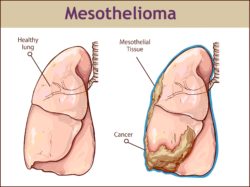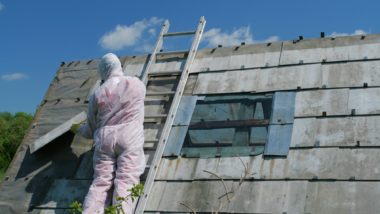Top Class Actions’s website and social media posts use affiliate links. If you make a purchase using such links, we may receive a commission, but it will not result in any additional charges to you. Please review our Affiliate Link Disclosure for more information.
While the use of asbestos in the U.S. may have ended long ago, the negative health effects of this once widely used material still linger in those suffering from asbestos related pleural disease.
Asbestos is a mineral that is extremely durable and fire-resistant. Those qualities made it popular in the building industry where for decades it was used to make insulation, roofing, and flooring materials, among other things. Inhaling asbestos fibers causes lung scarring and significant health risks, though.
The fibers are carried into the lower regions of the lung where they become permanently lodged in the lung walls.
What is Pleural Disease?
Asbestos related pleural disease generally refers to a disease of the pleura, which is a large, thin membrane that wraps around the lungs and lines the inside of the chest cavity. It includes asbestosis, pleural plaque, lung cancer, and mesothelioma.
Asbestosis, the most basic of pleural diseases, refers to scarring in the lungs caused by inhaled asbestos fibers, according to the University of Pennsylvania’s Perelman School of Medicine. The fibers become trapped in the lung tissue and cause damage, making it harder to breathe. Asbestosis is most often found in people who have had very high exposure to asbestos over a long period of time, but symptoms may not emerge for many years after.
Generic pleural disease occurs when the pleura becomes thickened. Diffuse pleural thickening is the term that describes changes to the overall pleura. When only certain areas of the pleura are thickened, the condition is called pleural plaques. When fluid builds up between the lungs and the pleura, a person is said to have pleural effusion.
When asbestos fibers cause significant enough scarring and inflammation, that irritation can cause changes to the lung tissue on a cellular level, which sometimes leads to the growth of tumors and lung cancer, the Perelman Medical School website explains. That usually doesn’t happen until long after a person has breathed in the asbestos fiber – 15 to 35 years.
Mesothelioma is a rare cancer and the only cancer type that’s directly caused by exposure to asbestos, the Perelman Medical School says. It can take 30 to 40 years for symptoms of the disease to surface. Mesothelioma can occur in the chest (pleural mesothelioma), the abdomen (peritoneal mesothelioma) or around the heart (pericardial mesothelioma.)
What are Asbestos Related Pleural Disease Symptoms?
The four basic types of asbestos related pleural disease share some common symptoms, but also have some hallmarks that are unique to each.
Patients with asbestosis commonly experience shortness of breath and persistent dry cough, a crackling sound in the lungs, tightness in the chest or chest pain, loss of appetite and weight loss and wider and rounds than normal fingertips, according to the American Lung Association.
Pleural plaques and pleural effusion tend to cause chest pain, usually sharp and worse when coughing or deep breathing, persistent cough, rapid breathing, shortness of breath, fever, chills and hiccups, the U.S. National Library of Medicine says. Yet in some patients, there are no symptoms of pleural plaques or effusion at all.
The American Cancer Society notes that as with asbestosis and pleural plaque and effusion, some of the most common symptoms of lung cancer include a persistent cough and chest pain that worsens with deep breathing and cough. Coughing up blood or rust-colored mucus, hoarseness, loss of appetite, weight loss and shortness of breath are also symptoms of lung cancer. So are wheezing, persistent upper respiratory infections, fatigue and weakness.
General mesothelioma symptoms often include fever, excessive sweating, fatigue, weight loss, blood clots, and loss of appetite. Mesothelioma of the chest can also cause cough, shortness of breath and chest pain as well as trouble swallowing, hoarseness, and swelling of the hands and face. Mesothelioma of the abdomen produces belly pain, swelling of the abdomen, nausea, vomiting, and constipation. Mesothelioma in near the heart often produces an irregular heart rhythm.
How Does Asbestos Related Pleural Disease Treatment Work?
Treatment for asbestos related pleural disease depends on the type and severity. Patients with lung cancer and mesothelioma in early stages may undergo surgery to remove the cancerous tissue – possibly even a lung transplant for those with lung cancer – and a combination of chemotherapy, radiation and immunotherapy to eradicate any remaining cells.
If the diseases aren’t caught until the late stages, surgery may not be an option and chemotherapy and radiation may be prescribed in addition to palliative care to ease the symptoms and make the patient more comfortable, according to the Mayo Clinic.
Mesothelioma and lung cancer are often aggressive diseases and neither has a total cure.
Treatment of asbestosis “focuses on slowing the progression of the disease, relieving symptoms and preventing complications,” the Mayo Clinic says. Patients are often prescribed oxygen and encouraged to participate in pulmonary rehabilitation, which includes breathing and relaxation techniques. In severe cases, a lung transplant may be considered.
Patients with pleural thickening are treated according to their symptoms because there is no cure for the thickening itself. In some cases, treatment is unnecessary and the focus is on monitoring the patient’s condition closely.
Who is at Risk for Asbestos Related Pleural Disease?
Individuals who have been exposed to asbestos over long periods of time, in large quantities, or both are at higher risk for developing asbestos related pleural disease. Smokers are at an even greater risk.
Occupations that may place people at risk of exposure to asbestos include construction, electrical work, railroad or shipyard work, auto or aircraft mechanics, roofing, insulating, firefighting, factory work, pipefitting, plastering, and more. Although many people who work in high-risk occupations wear personal protective equipment to prevent them from breathing in asbestos fibers, some companies do not provide it and some people may not even be aware of the risks.
People who work in these fields may also need to be careful not to bring asbestos particles home with them. The particles may stick to hair, skin, clothing, or shoes. It is important to remove these contaminated items and shower before leaving an asbestos-contaminated job site. These items should be washed separately from non-contaminated clothing.
Many spouses and children of workers who have been exposed to asbestos at their job are at risk of second hand asbestos exposure. As asbestos related pleural disease may take decades to develop, it is important to prevent exposure from happening now. By the time the condition is diagnosed, it is generally much too late to prevent the damage.
Many people who do not work in asbestos-related fields may also be at risk of inhaling the material. Old office buildings, schools, and apartment buildings often still contain asbestos floor or ceiling tiles, insulation, or textiles. If these items are in a state of disrepair, they may release asbestos fibers into the air where they can be inhaled by people who live, work, or go to school in the building.
Can You File an Asbestos Exposure Lawsuit?
Lawsuits over asbestos exposure and its medical consequences have been filed against countless companies. Many plaintiffs seek compensation for medical issues such as mesothelioma, lung cancer, and other asbestos related pleural disease.
In some cases, these lawsuit have been able to recover thousands of dollars. This month, apartment complex builders agreed to pay $335,000 to the Massachusetts Attorney General to resolve allegations that they mishandled abatement. Under the terms of the deal, Washington Mills II LLP agreed to pay $175,000 while PC Construction Company agreed to pay $160,000.
When redeveloping a former manufacturing sight in Lawrence, Massachusetts, the companies allegedly violated the state’s Clean Air Act and the Solid Waste Management Act through several actions. First, the company allegedly failed to properly abate asbestos-containing construction materials in accordance with workplace safety requirements. The state attorney general also alleged that the companies illegally stockpiled asbestos containing materials and even reused these materials without authorization required under state law.
Although this case was filed by Massachusetts Attorney General Maura Healey, private citizens can also serve as plaintiffs in asbestos exposure lawsuits. In these cases, plaintiffs can make claims against employers, landlords, schools, local companies, and other entities which may be responsible for asbestos exposure.
Through a lawsuit or even a class action lawsuit, plaintiffs can recover monetary compensation for damages such as medical expenses, pain and suffering, loss of enjoyment of life, loss of earning capacity and more. Family members of sick or deceased people may also be able to serve as plaintiffs, seeking compensation for financial injuries, wrongful death, loss of consortium, and more.
Those who have been exposed to asbestos and later developed asbestos related pleural disease may consider taking legal action, possibly joining a class action lawsuit. Medical bills can be costly and participating in a class action lawsuit could result in financial compensation. One way to get the information needed to decide whether a class action lawsuit is feasible is to consult with a qualified, experienced attorney specializing in asbestos litigation.
Join a Free Asbestos Cancer Class Action Lawsuit Investigation
If you or a loved one have been exposed to asbestos and were subsequently diagnosed with the following asbestos-related illnesses:
- Mesothelioma
- Lung cancer
- Larynx cancer
- Esophageal cancer
- Colon cancer
- Pulmonary asbestosis
- Asbestos-related pleural disease,
… then you may be eligible to file an asbestos lawsuit to seek compensation for your medical expenses, lost wages, pain and suffering, and other losses you have experienced.
If your loved one has passed away, you may also be able to file a wrongful death lawsuit to seek compensation for funeral expenses and other costs associated with your loved one’s illness.
Obtain a free case review now by filling out the form on this page.
An asbestos attorney will contact you if you potentially qualify to file an asbestos lawsuit or class action lawsuit. There is no cost or obligation associated with this case evaluation.
ATTORNEY ADVERTISING
Top Class Actions is a Proud Member of the American Bar Association
LEGAL INFORMATION IS NOT LEGAL ADVICE
Top Class Actions Legal Statement
©2008 – 2024 Top Class Actions® LLC
Various Trademarks held by their respective owners
This website is not intended for viewing or usage by European Union citizens.
Get Help – It’s Free
Join a Free Asbestos Cancer Class Action Lawsuit Investigation
If you qualify, an attorney will contact you to discuss the details of your potential case at no charge to you.
PLEASE NOTE: If you want to participate in this investigation, it is imperative that you reply to the law firm if they call or email you. Failing to do so may result in you not getting signed up as a client or getting you dropped as a client.
E-mail any problems with this form to:
Questions@TopClassActions.com.
Oops! We could not locate your form.













